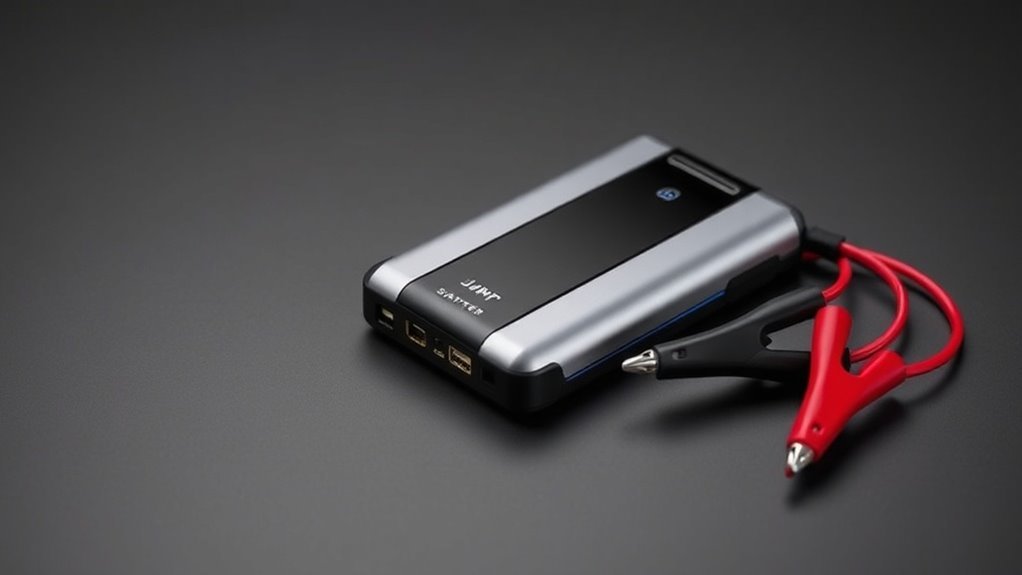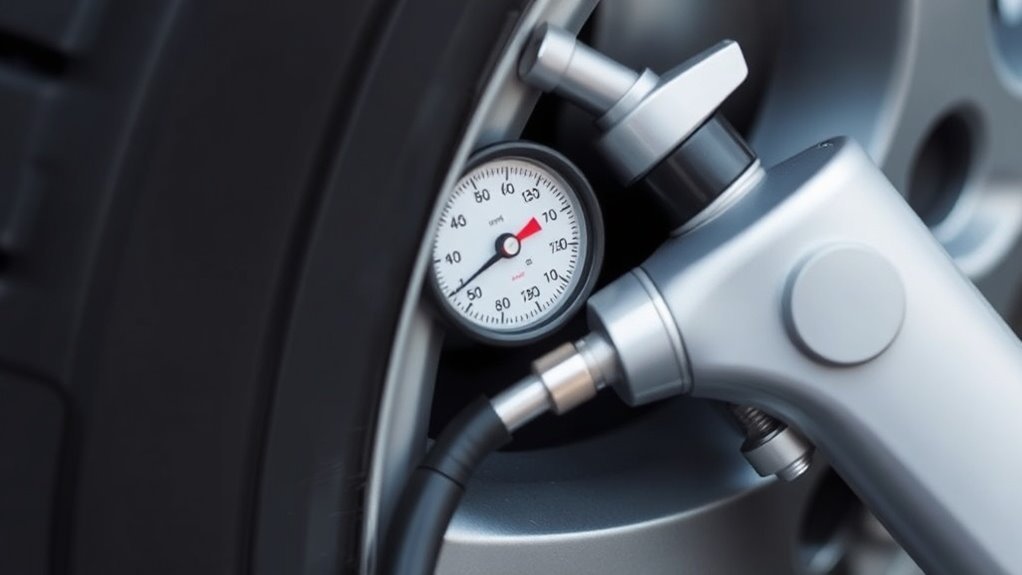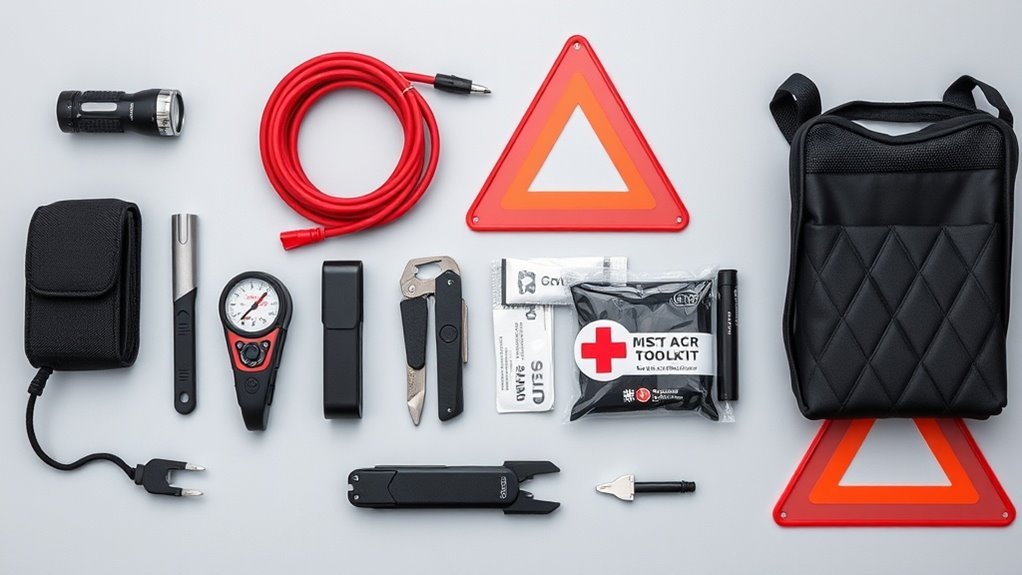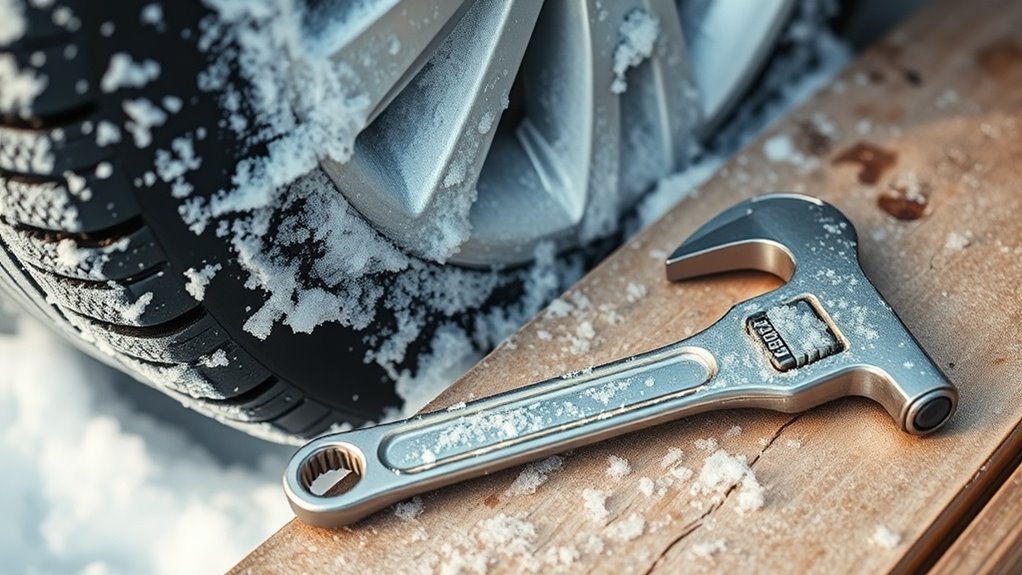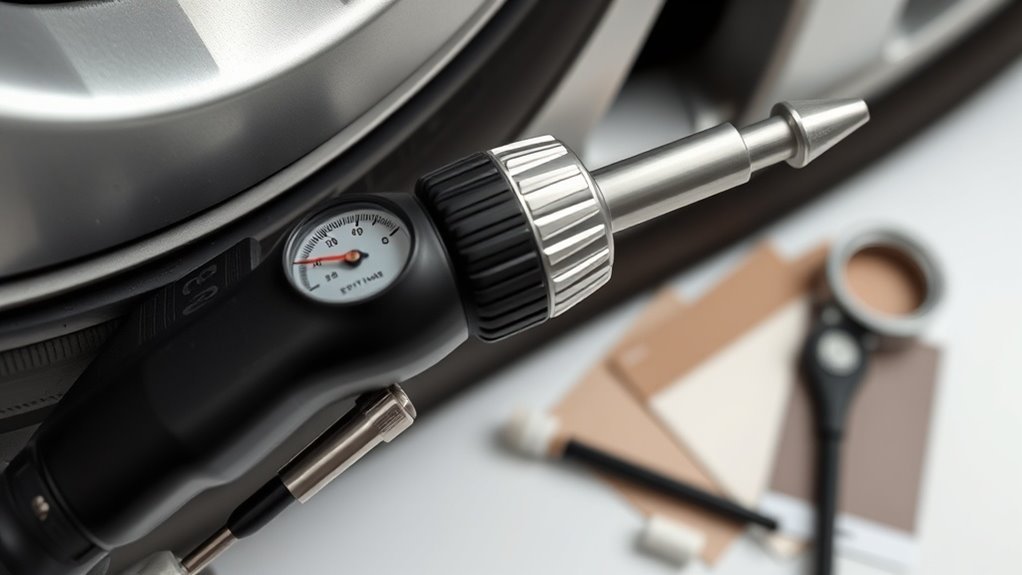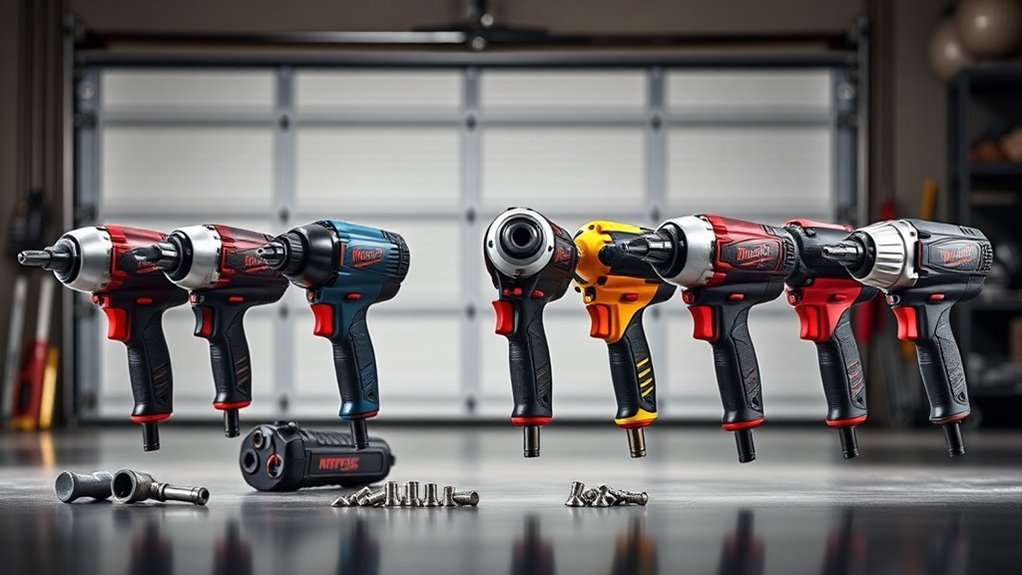Essential Lubrication Tools in Car Maintenance
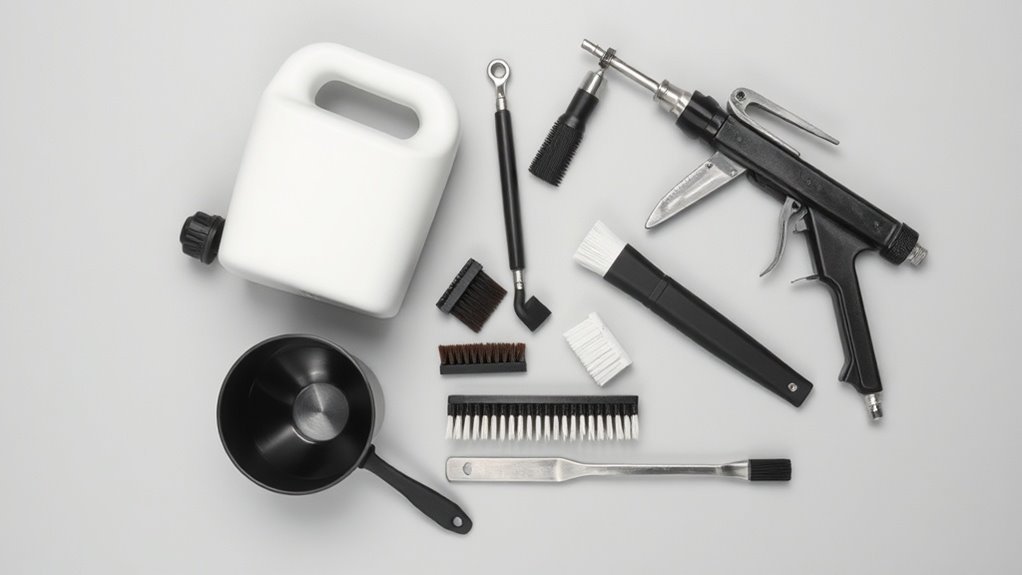
Essential lubrication tools are vital for your car’s maintenance. You’ll need engine oil, transmission fluid, and brake fluid to keep everything running smoothly. A grease gun, whether manual or electric, helps apply grease to fittings. Don’t forget cleaning accessories like microfiber towels and quality car wash soap for a polished look. Safety gear, such as gloves and goggles, is a must to protect yourself during maintenance tasks. Find out what else you need for ideal vehicle care.
Key Takeaways
- Engine oil, transmission fluid, brake fluid, and power steering fluid are vital for vehicle performance and longevity.
- Different types of grease guns, such as manual, pneumatic, and battery-operated, suit various lubrication needs.
- Proper usage techniques include purging air from the gun and applying short bursts to avoid over-lubrication.
- Regular maintenance of lubrication tools and equipment ensures efficiency and extends their lifespan.
- Personal protective equipment like gloves and goggles is essential for safety during lubrication tasks.
Essential Lubrication Fluids
When it comes to maintaining your car, knowing the essential lubrication fluids is key to keeping everything running smoothly.
You’ll want to start with engine oil, which reduces friction and prevents wear inside the engine. It’s important to check levels regularly and change it according to your manufacturer’s recommendations.
Next up is transmission fluid; it helps guarantee smooth gear shifts and protects against overheating.
Don’t forget brake fluid, which is essential for safe stopping; low levels can compromise your braking system.
Brake fluid is crucial for safe stopping; ensure levels are adequate to maintain your braking system’s effectiveness.
Finally, power steering fluid enhances steering responsiveness.
Familiarizing yourself with these fluids, their levels, and their maintenance won’t only extend your car’s lifespan but also enhance your driving experience.
Keep them in mind for safer and smoother rides!
Lubrication Guns
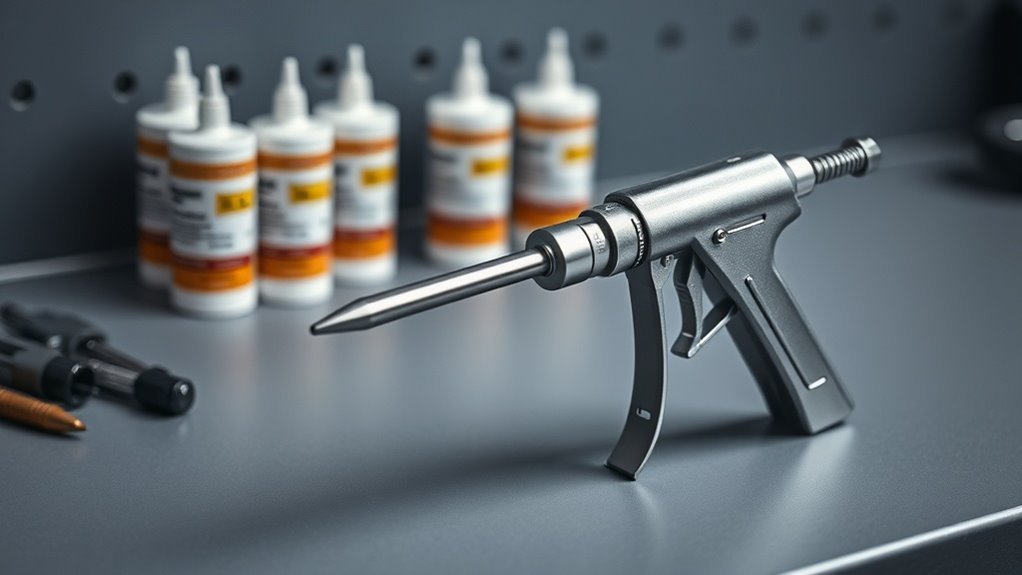
When it comes to keeping your car running smoothly, lubrication guns are essential tools.
You’ll find various types of lubrication guns, each with unique components and specific usage techniques. Understanding these elements can make your maintenance routine much more efficient and effective.
Types of Lubrication Guns
There are several types of lubrication guns available, each designed to make the task of applying grease easier and more efficient.
You’ll encounter manual grease guns, which require you to pump a handle to dispense the grease. They’re simple to use and great for small jobs.
Then, there are pneumatic grease guns that use compressed air for quick and consistent application, which can save you time during larger tasks.
Battery-operated grease guns offer convenience and portability, allowing you to work without being tethered to a power source.
Finally, there’s the electric grease gun, ideal for heavy-duty jobs, as they provide consistent pressure and reduce hand fatigue.
Choosing the right type depends on your specific needs and preferences.
Lubrication Gun Components
While understanding the components of lubrication guns can enhance your maintenance efficiency, it’s important to know what each part does. The main components include the barrel, plunger, and nozzle. The barrel holds the lubricant, while the plunger pushes it out through the nozzle, which directs the flow precisely where you need it.
Here’s a quick overview of these essential parts:
| Component | Function |
|---|---|
| Barrel | Holds the lubricant |
| Plunger | Pushes lubricant out |
| Nozzle | Directs lubricant to specific areas |
Familiarizing yourself with these components will help you make the most out of your lubrication gun, ensuring proper maintenance and greater efficiency. Let’s keep your car running smoothly!
Proper Usage Techniques
Mastering proper usage techniques with lubrication guns will greatly enhance your maintenance routine.
First, verify you’ve selected the right type of lubricant for your vehicle’s needs. When loading the gun, make sure to purge out any air by pulling the trigger until you see a steady flow of grease.
Position the nozzle directly on the grease fitting and maintain firm pressure; too much pressure can damage fittings. Apply short bursts instead of continuous shots, as this prevents over-lubrication and waste.
Keep an eye on the lubricant’s volume, and step back briefly to check for any leaks. Finally, clean the nozzle after use to prevent contamination.
Oil Change Tools
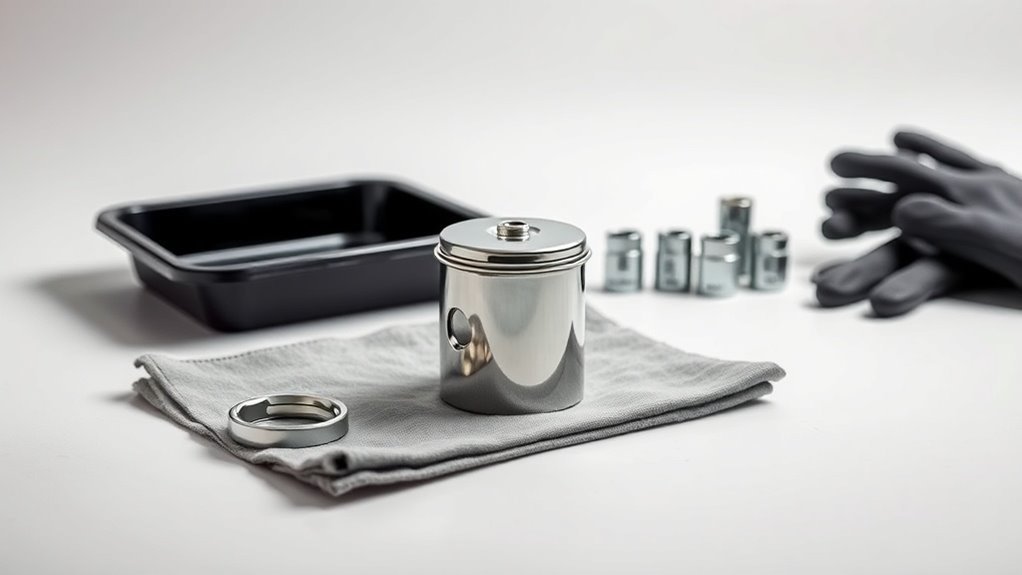
Changing your engine oil is one of the most vital maintenance tasks for keeping your car running smoothly, and having the right tools can make the process considerably easier.
First, you’ll need an oil filter wrench to remove the old filter without much hassle. A socket wrench is important for draining the oil from the pan.
Don’t forget an oil catch pan to collect the used oil—this keeps your workspace clean and safe. An oil funnel is helpful for pouring in new oil without spilling.
Finally, having fresh oil and a new filter ready to go guarantees you’re all set. Additionally, knowing how to perform routine maintenance can help you recognize when it’s time for an oil change. With these tools in hand, you can easily tackle your oil change and keep your engine in top shape.
Grease Fittings and Injectors
After guaranteeing your engine oil is fresh, it’s time to contemplate how you’re maintaining other parts of your vehicle, specifically the lubrication points like grease fittings and injectors. Grease fittings help keep moving parts functioning smoothly by allowing for easy lubrication. Meanwhile, injectors ascertain lubrication reaches those hard-to-reach areas, minimizing friction and wear.
Here’s a quick comparison to help you remember their roles:
| Feature | Grease Fittings |
|---|---|
| Purpose | Easy lubrication access |
| Commonly Found In | Joints, bearings, and suspension |
| Maintenance Frequency | Regular intervals (check often) |
| Type of Lubricant | Grease |
| Difficulty to Use | Usually simple |
Knowing how to use these tools effectively is essential for longevity and peak performance!
Cleaning and Maintenance Accessories
When it comes to keeping your car in top shape, essential cleaning supplies are a must-have.
You’ll want to establish a regular maintenance schedule to stay on track, and proper tool storage will help keep everything organized.
With the right accessories, you can make car care much easier and more effective. Regular maintenance can enhance the longevity of your tools, much like how proper storage can protect your car’s essential accessories.
Essential Cleaning Supplies
Keeping your vehicle in prime condition goes beyond just regular oil changes; it also involves using essential cleaning supplies that help maintain its appearance and functionality.
Start with a quality car wash soap to remove dirt without harming the paint. Microfiber towels are a must-have for drying and polishing surfaces without leaving scratches. Invest in a reliable wheel cleaner to tackle brake dust and grime on your rims. Don’t forget about glass cleaner for a streak-free shine on your windows.
For interiors, a good upholstery cleaner helps keep fabric seats looking fresh, while an all-purpose cleaner can tackle various surfaces, including dashboards.
With these essential cleaning supplies, you’ll guarantee your car remains visually appealing and in peak working condition.
Regular Maintenance Schedule
A regular maintenance schedule is essential to guarantee your car operates smoothly and lasts longer. By staying on top of cleaning and maintenance accessories, you can prevent issues before they arise.
Make a habit of checking fluid levels, changing filters, and lubricating moving parts regularly. Each task helps your vehicle perform at its best.
Don’t forget to clean both the interior and exterior. A clean engine can enhance performance, while a tidy cabin improves your driving experience.
Investing in quality cleaning tools and lubricants will save you time and money in the long run.
Set reminders for maintenance tasks, and stick to them. Keeping your car well-maintained isn’t just about convenience; it’s about ensuring safety and reliability for every drive.
Proper Tool Storage
Proper tool storage is essential for maintaining the efficiency and longevity of your cleaning and maintenance accessories.
When you’ve invested in quality tools, keeping them organized and protected is key. Here are four items to help you store your tools properly:
- Toolboxes – Keep your tools in sturdy, designated boxes to avoid damage and loss.
- Magnetic Strips – These are perfect for hanging wrenches and screwdrivers, ensuring they’re always within reach.
- Ziplock Bags – Ideal for smaller accessories like nuts, bolts, and cleaning supplies, preventing clutter.
- Pegboards – Great for visualizing and organizing tools, allowing you to easily grab what you need without digging through a bin.
With proper storage, your tools will stay in top condition, ready for your next maintenance session!
Safety Equipment
While you may be focused on the mechanical aspects of car maintenance, never underestimate the importance of adequate safety equipment. Protective gear like gloves, goggles, and sturdy footwear is essential. They’ll shield you from hazards like sharp tools and hot surfaces.
Also, consider using a proper ventilation system or mask when working with lubricants or chemicals to avoid inhalation risks. A first aid kit is a must—accidents can happen, so being prepared can make all the difference.
Lastly, don’t forget about a fire extinguisher, especially when working with flammable materials. Your safety should always come first. Additionally, investing in these safety tools not only protects you but also helps in maintaining a more efficient workflow during your car maintenance tasks.
Questions
How Often Should I Lubricate My Car Components?
You should lubricate your car components every 3,000 to 5,000 miles, or as recommended in your owner’s manual. Regular maintenance helps prevent wear and tear, keeping your vehicle running smoothly for longer.
What’s the Difference Between Grease and Oil for Lubrication?
Grease has a thicker consistency and provides long-lasting protection for components under heavy load, while oil, being thinner, flows easily and cools parts but may require more frequent application. Choose based on your needs!
Can I Use Household Oils for Car Maintenance?
You can’t use household oils for car maintenance; they’re too light and lack the necessary additives. Imagine your engine sounding like a squeaky toy—it’s not gonna end well. Stick to automotive oils for best results!
What Are the Signs of Insufficient Lubrication in My Car?
You’ll notice signs like unusual noises, increased friction, overheating components, or sticky parts. If your oil light turns on, it’s vital to check for low oil levels or contamination. Regular maintenance can prevent these issues.
How Do I Dispose of Used Lubrication Fluids Properly?
Did you know that improperly disposed of lubrication fluids can contaminate up to 1 million gallons of fresh water? To dispose of used fluids properly, take them to a local recycling center or auto shop that accepts them.
Conclusion
In the dance of car maintenance, keeping your vehicle gliding smoothly requires the right lubrication tools. Just like a well-tuned orchestra, each component plays a vital role in harmony. With essential fluids, guns, and oil change tools at your fingertips, you’re the maestro of your car’s performance. Don’t forget the safety equipment and accessories to guarantee a flawless performance. Embrace these unsung heroes of maintenance, and watch your trusty steed purr like a contented cat on a sunny afternoon.

